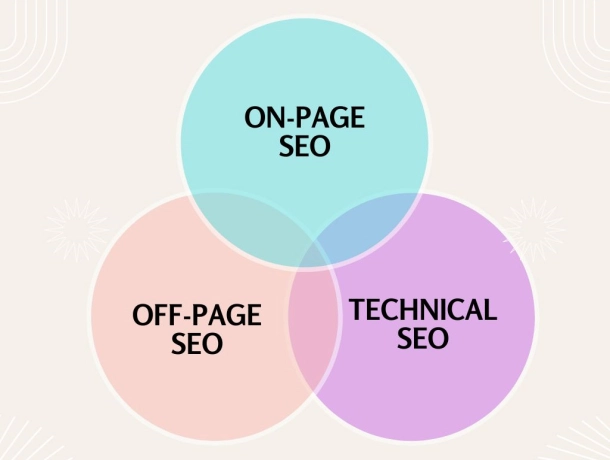
- August 7, 2023
- Digital Marketing, SEO types
- Search Engine Optimisation (SEO)
What is technical SEO?
The process of enhancing a website’s technical components to raise its search engine ranking and visibility is known as technical SEO. Technical SEO is making adjustments to a website‘s server configuration, coding, and infrastructure to improve the speed and ease with which search engines can crawl and index its content.
Guide to technical SEO best practices include enhancing website speed, making it responsive to mobile devices, using schema markup, producing an XML sitemap, enhancing website security, and making sure URL structures are correct. In addition to enhancing the website’s architecture, broken links, duplicate content, and crawl mistakes, technical SEO also includes optimising the website’s content management system (CMS).
Because it ensures that the website is well-structured and optimised for search engines, technical SEO is essential for website visibility and search engine ranking. Website owners can increase their website’s search engine position and exposure by applying technical SEO best practices, which can then result in an increase in traffic, leads, and sales.
Guide to technical SEO
Technical SEO is crucial because it makes it easier for search engines to crawl properly, index, and understand your website. This can ultimately result in higher search engine ranks and increased website traffic. Here are a few justifications for why technical SEO is crucial:
- Better website performance: Technical SEO can aid in increasing website speed, mobile friendliness, and user experience, which can increase engagement and decrease bounce rates.
- Improved search engine visibility: Your website is more likely to show up in search results for pertinent queries when search engines can simply crawl and index it.
- Checks for duplicate content: Technical SEO can assist in addressing problems like duplicate content, broken links, and crawl mistakes that can have a negative influence on search engine rankings.
- Website security: Technical SEO may assist in making sure that your website is safe from hacking and other security risks, which can help increase user confidence.
Difference between Technical SEO v/s Off-Page SEO v/s ON-Page SEO

Three main components of search engine optimization—technical SEO, off-page SEO, and on-page SEO—each having a distinct focus and set of objectives.
Technical SEO focuses on a website’s technical characteristics and works to improve its architecture and backend elements so that search engines may more easily crawl, index, and comprehend the website. This includes, among other technical issues, enhancing website security, maintaining proper URL structure, and optimising website speed and mobile friendliness.
On-page SEO makes a website’s individual pages more relevant and valuable to users and search engines, SEO focuses on improving each page’s content, structure, and user experience. Among other on-page elements, this entails optimizing the meta descriptions, headers, internal links, text, and graphics.
Off-page SEO focuses on enhancing a website’s authority and reputation in the eyes of visitors and search engines, and it entails actions that don’t happen on the actual website. This includes techniques like link-building and social media marketing that can increase a website’s visibility, authority, and online presence.
Technical SEO is concerned with the technical framework of the website, on-page SEO is concerned with optimising specific website pages, and off-page SEO is concerned with enhancing a website’s online visibility and reputation through initiatives that don’t directly involve the website. These three are crucial components of an all-encompassing SEO strategy, and each one contributes differently to raising a website’s visibility and search engine rating.
Fundamentals of technical SEO audit

A technical SEO audit examines the technical aspects of a website to find any problems that might be impairing its search engine performance. The foundations of a technical SEO audit are as follows:
- Website crawling: The first step is to use a web crawler programme to crawl the website in order to find any technical problems, such as broken links, duplicate content, and crawl errors.itecture.
- Verify your site’s speed and mobile friendliness: These are crucial elements for user experience and search engine ranking. To test a site’s performance and mobile responsiveness, utilise tools like Google PageSpeed Insights and Mobile-Friendly Test.
- Examine the site architecture: This covers the way the pages are set up and the internal linking scheme. It is simpler with a well-structured website. Easy crawling and indexing of the site by search engines are facilitated by a well-organized site arch
- Verify the URL structure: URLs should contain relevant keywords and be short and descriptive.
- Examine the XML sitemap: An XML sitemap enables search engines to comprehend the organisation of a website and to recognise all the pages that require indexing.
- Verify robots.txt: This file instructs search engine crawlers which pages to index and which to skip. Ensure that the file is correctly set up to allow crawlers to reach crucial pages. Verify for duplicate content because it can negatively affect search engine performance. To find duplicate material on your website, use tools like Copyscape, then take the necessary actions to
- Examine the metadata: On-page elements that can affect search engine results include title tags and meta descriptions. Verify that they have been correctly optimised for the desired keywords. Search engines can better understand a website’s content by using structured data, which can also increase a website’s exposure in search results. Check to see if structured data is being used on your website.
In order to find any problems that might be hurting a website’s search engine performance, a technical SEO audit entails a thorough analysis of all its technical components. Website owners can increase their website’s search engine exposure and consequently drive more traffic by correcting these concerns.
Crawlability checklist
Here is a crawlability checklist to help you make sure that search engines can easily crawl your website:
- Verify that you have a robots.txt file that lists the URLs and directories that should be crawled and the ones that should not.
- Look for a sitemap in order to assist search engines in locating and indexing all of the pages on your website, create an XML sitemap and submit it to Google Search Console.
- If any links on your website are broken, find them using a tool like Screaming Frog or Google Search Console and fix them.
- To find and remove any duplicate content from your website, use a programme like Copyscape or Siteliner.
- To find and remove any redirect chains from your website, use a programme like Screaming Frog or Redirect Checker.
- Inspect your website for crawl issues. If you find any, use Google Search Console to find and solve them.
- Ensure that each page has canonical tags in order to prevent problems with duplicate content and to guarantee that the right version of each page is being indexed.
- Use hreflang tags to specify which version of a page should be provided to users in various locales and languages if your website supports several languages.
- Employ schema markup to make your website more aesthetically pleasing and to aid search engines in understanding the material on your site.
Following this crawlability checklist can help you make sure that your website is simple for search engines to crawl, which can enhance your website’s visibility and search engine rankings.
Indexability Checklist
Here is a list of things to check to make sure search engines can simply index your website:
- Verify for blocked pages: Use the robots.txt file or meta tags to make sure that none of your crucial pages is prevented from being indexed by search engines. Ensure none of your critical pages has the no index tag, which prohibits them from being indexed by search engines, by checking for it.
- Check for canonical tags: Use canonical tags to tell search engines which version of each page should be indexed. Inspect your website for crawling issues. If you find any, use Google Search Console to find and solve them.
- Check for duplicate material: To find and remove any duplicate content from your website, use a programme like Copyscape or Siteliner.
- Verify for thin content: Too little content can impair a page’s ability to be indexed, so make sure your pages have enough.
- Verify any broken links: If any links on your website are broken, find them using a tool like Screaming Frog or Google Search Console and fix them. Use hreflang tags to specify which version of a page should be provided to users in various locales and languages if your website supports several languages.
- Verify the schema markup: Employ schema markup to enhance the visibility of your listings in search results and to aid search engines in understanding the material on your website.
You can make sure that your website is quickly indexed by search engines by using this indexability checklist, which can enhance your website’s exposure and search engine rankings.
Renderability checklist
Here is a renderability checklist to help you make sure that search engines can easily render your website: Verify your CSS and JavaScript files to ensure that they are correctly loaded and not blocking search engines.
- Verify the server response time: If your server takes too long to respond, it will affect how renderable your website is. Verify your website’s mobile responsiveness to ensure that it can be easily rendered on smaller displays and is optimized for mobile devices.
- Look for structured data: Search engines will understand your website’s content better if you use structured data, and your listings will seem better in search results. Look for structured data.
- Look for pictures: The presentation of your website will be slowed down if your photos are too huge and are not appropriately optimised for search engines.
- Examine the page speed: To find any problems that might be causing your website to render slowly, use a tool like Google PageSpeed Insights.
- Check for server issues: To find any server errors that might be hurting the renderability of your website, use a tool like Google Search Console.
- Check for redirects: To find and resolve any redirect issues that might be hurting the renderability of your website, use a tool like Redirect Checker. Ensure that your website can be simply produced and is compatible with all major browsers. You may make sure that your website is easily rendered by search engines by using this renderability checklist, which can enhance your website’s visibility and search engine rankings.
Clickability checklist
To assist you in making sure your website is optimised for click-through rates, here is a clickability checklist:
- An excellent meta title and description should appropriately reflect the content of your pages.
- To make your listings more clickable and more appealing in search results, use rich snippets and schema markup.
- To increase click-through rates, strive to have your material appear in Google’s featured snippets.
- To increase click-through rates and make your material more appealing, use high-quality images and videos.
- To persuade users, employ calls to action that are obvious and appealing.
Rankability checklist
Included below is a rankability checklist to help you make sure your website is ready to rank well in search results:
- To find the finest keywords to target for your website, conduct extensive keyword research.
- Verify your pages’ on-page optimisation by including the keywords you’ve chosen in the meta tags, headers, and text.
- Ensure sure your website has valuable, interesting material that offers value to your users by checking for high-quality content.
- To increase the authority and ranks of your website, create high-quality backlinks to it from reliable websites.
- Utilize social media to promote your website and develop social signals that can help to boost your rankings. Look for social signals.
- Verify your website’s responsiveness to mobile devices to ensure that it can be used on smaller displays and is mobile-friendly.
- Concentrate on offering a fantastic user experience, as this can raise your website’s search engine results and increase visitors.
- Find and resolve any crawl mistakes or broken links that may be hurting your website’s ranks technically.
- You may help your website’s search engine ranks and exposure, which can increase traffic and boost your online presence, by adhering to these rankability criteria.
Best technical SEO agency in India

Investigate and assess technical SEO companies based on their expertise, track record, customer references, case studies, and cost. You can also take into account things like the agency’s proficiency with technical SEO, its strategy for SEO audits, and their capacity to offer specialised solutions based on the demands of your website. It’s crucial to thoroughly weigh your options and select a company that can provide the outcomes you’re after.
Conclusion
A guide to technical SEO is crucial since it ensures that your website is well-structured, optimised, and safe, all of which can enhance your audience’s user experience and search engine rankings. Even if you have high-quality content, your website may struggle to rank highly in search results if the technical aspects are not optimised properly. The use of structured data markup to help search engines better comprehend your material, the use of canonical tags to minimise duplicate content issues, and the optimizing site speed are some of the major components of technical SEO. You may improve search engine understanding of the material on your website and increase visibility and ranking by taking care of these technical SEO variables.












